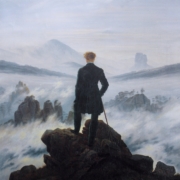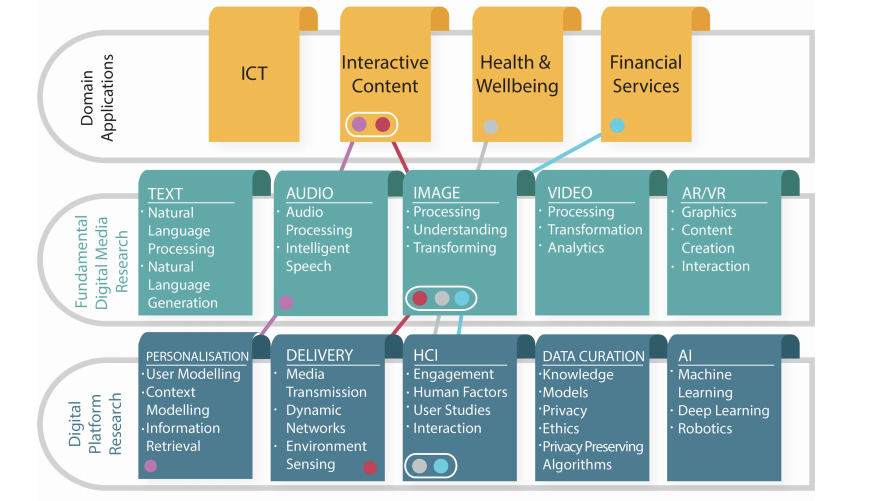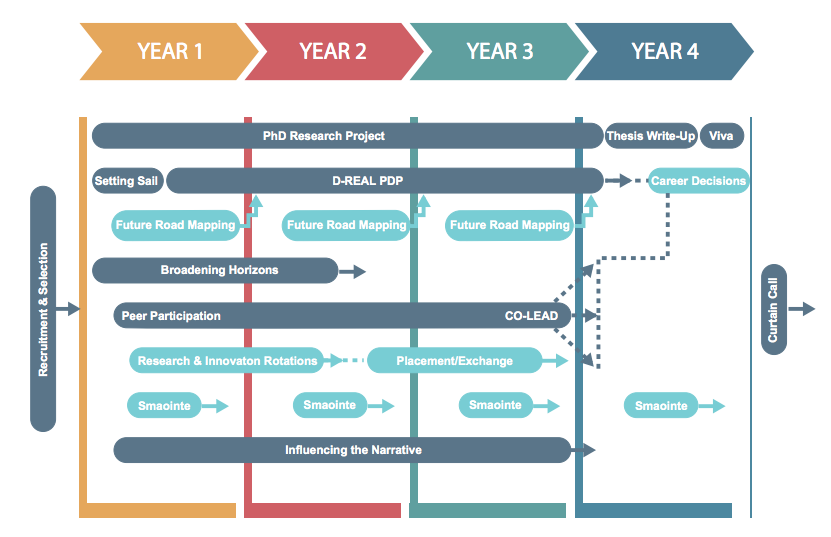Awe in a headset: using emotion science for positive impact
Paul Vasquez’s ‘Double Rainbow’ viral video now has over 50 million views. In just over three minutes, the video encapsulates a raw, unfiltered human reaction to the awe-inspiring power of nature. Vasquez’s deeply personal and emotional response resonated with many viewers, making the video an internet sensation and cultural reference point. In the clip, the camera captures the visual splendour of a vibrant double rainbow across a mountainous backdrop, near Yosemite National Park. The inner and larger rainbow displays a full arc while the second, fainter rainbow is visible partially. The sky between the two rainbows appears darkened, emphasizing the intensity and brilliance of the colours. Paul Vasquez’s voice can initially be heard in a state of disbelief, uttering exclamations like “Whoa!” and “Oh my God!” repeatedly, overwhelmed by the sheer scale and vivacity of the rainbows.
As the video progresses, his vocalizations become more intense. He starts questioning aloud, “What does this mean?” This perhaps points to a profound, introspective moment where the visual spectacle in front of him leads him to reflect upon larger existential themes or personal significance. His emotional state appears to heighten even further when he notices that the rainbow forms a full arc, and he cries out, “It’s a full-on double rainbow all the way across the sky!” His voice quivers with emotion, and it’s evident that he is profoundly moved. The phrase “all the way” becomes a focal point of his reaction, emphasizing the completeness and perfection of the phenomenon.
His experience, as highlighted by Professor Dacher Keltner1, is a prime example of an awe-filled experience, in terms of elicitors, physiological, temporal and vocal experience. Awe is defined as the feeling of being in the presence of something vast that transcends your current understanding of the world2. It forces an expansion of the mental schemas that we develop growing up, acting as frames of reference we use to understand the world3. In the face of a new experience, this expansion is referred to as an accommodation, as opposed to an assimilation for the experience would match our frame of reference.
Awe prompts accommodation when the experience is perceived as vast, and this vastness can be conceptual or physical. Keltner & Haidt2 highlight eight ‘wonders of life’ most likely to prompt vastness and where people will find awe: moral beauty (witnessing acts of courage or kindness), collective effervescence (blending into a united collective e.g. singing with the crowd in a concert), nature, music, visual design, spirituality and religion, life and death, and epiphanies (pieces of information and reasoning coming together into a structured thesis about the world). They also found that awe is ambivalent and can be negative (e.g., witnessing a tornado approaching)4 when found in more threatening situations, but is a very rare occurrence, while moral beauty accounts for most of the reported awe-filled situations.
My research focuses on awe as an emotional experience, and how it can be designed into virtual reality experiences for positive benefits. Awe is more than ‘whoa’s and ‘wow’s (referred to as vocal bursts), it is a transformative experience that changes the way we perceive things. It leads to this dissolution of the self, where one’s perception shifts from an egotistical perspective to a larger, more interconnected perspective. Feelings of unity with others, with a community, with the universe, as they exist with psychedelic experiences5. This shift leads to a more receptive mindset that makes space for openness to new experiences6, critical thinking7, and curiosity8. More importantly (to me and my research), experiencing awe is known to drive altruism and sacrifice for the benefit of others, quieting the dog-eat-dog mindset for collective thriving9–11. This, in turn, is a path to the reduction of anxiety and depression12,13.
To design awe, we need not only to know what awe is at the semantic level but also its cognitive processes and its indices (physiological, neurological, behavioural, self-reported), so we can better define and measure it. The problem is that awe is known to be so elusive that it resists precise definition and measurement, which are foundational for scientific experiments and developing our understanding of it. Research has found that positive and negative awe trigger different physiological responses14 and activate overlapping but different brain structures involved in self-other representation, incongruency detection and self-reflection15. This means that there are no clear-cut patterns when it comes to neurophysiological markers of awe. Behavioural expressions, more specifically facial expressions and vocal bursts, have turned out to be more consistent indicators of awe, shown to be almost universal16. On the other hand, the use of self-reports to measure awe raises an epistemic question about the nature of awe as a learned semantic category that agglomerates language, past experiences, physical sensations (from physiological responses) and brain activity into a meaning-making emotion17,18. This approach highlights how an experience that one might label as awe can be very different from somebody else’s construction, due to differences across individuals, groups, cultures, or even within oneself at different points in time.
It seems however that some companies, like LiminalVR, have been able to capture and design elicitors of awe into virtual reality experiences. Their evidence-based experiences mostly leverage nature stimuli and play around with size and scale to spark perceived vastness – which becomes an awe-filled cocktail when coupled with the novelty effect of VR. VR is a unique medium that can provide highly immersive experiences, which makes it the best candidate to convey effective awe-filled situations – not only nature or music-based but touching more specific themes like moral beauty and collective effervescence – and these themes are also more likely to be found in everyday life, so they might better reflect relatable awe-filled experiences.
I believe that scientific evidence can powerfully inform the design of immersive experiences and that these should be leveraged for the benefit of people. This approach has been driving a collaborative project between my lab and the Crumlin’s Children Hospital in Dublin. We are implementing VR to help children lower their anxiety by fostering sense-making, agency, fun, and empowerment. If you are curious about this grounded application of my research, you can find more in this webinar and in this TEDx talk.
References:
- Keltner D. Awe: The New Science of Everyday Wonder and How It Can Transform Your Life. Penguin Publishing Group; 2023. https://books.google.ie/books?id=LEGREAAAQBAJ
- Keltner D, Haidt J. Approaching awe, a moral, spiritual, and aesthetic emotion. Cogn Emot. 2003;17(2):297-314. doi:10.1080/02699930302297
- Piaget J, Cook M, others. The Origins of Intelligence in Children. Vol 8. International Universities Press New York; 1952.
- Gordon AM, Stellar JE, Anderson CL, McNeil GD, Loew D, Keltner D. The dark side of the sublime: Distinguishing a threat-based variant of awe. J Pers Soc Psychol. 2017;113(2):310-328. doi:10.1037/pspp0000120
- Hendricks PS. Awe: a putative mechanism underlying the effects of classic psychedelic-assisted psychotherapy. Int Rev Psychiatry. 2018;30(4):331-342. doi:10.1080/09540261.2018.1474185
- Silvia PJ, Nusbaum EC, Beaty RE. Supplemental Material for Openness to Experience and Awe in Response to Nature and Music: Personality and Profound Aesthetic Experiences. Psychol Aesthet Creat Arts. 2015;9(4):376-384. doi:10.1037/aca0000028.supp
- Gottlieb S, Keltner D, Lombrozo T. Awe as a Scientific Emotion. Cogn Sci. 2018;42(6):2081-2094. doi:10.1111/cogs.12648
- Anderson CL, Dixson DD, Dante D. Dixson, Dante D. Dixson, Monroy M, Keltner D. Are awe-prone people more curious? The relationship between dispositional awe, curiosity, and academic outcomes. J Pers. 2020;88(4):762-779. doi:10.1111/jopy.12524
- Perlin JD, Li L. Why Does Awe Have Prosocial Effects? New Perspectives on Awe and the Small Self: Perspect Psychol Sci. 2020;15(2):291-308. doi:10.1177/1745691619886006
- Piff PK, Dietze P, Feinberg M, Stancato DM, Keltner D. Awe, the small self, and prosocial behaviour. J Pers Soc Psychol. 2015;108(6):883-899. doi:10.1037/pspi0000018
- Stellar JE, Gordon AM, Piff PK, et al. Self-Transcendent Emotions and Their Social Functions: Compassion, Gratitude, and Awe Bind Us to Others Through Prosociality. Emot Rev. 2017;9(3):200-207. doi:10.1177/1754073916684557
- Chirico A, Gaggioli A. The Potential Role of Awe for Depression: Reassembling the Puzzle. Front Psychol. 2021;12:617715. doi:10.3389/fpsyg.2021.617715
- Monroy M, Keltner D. Awe as a Pathway to Mental and Physical Health. Perspect Psychol Sci. 2023;18(2):309-320. doi:10.1177/17456916221094856
- Zickfeld JH, Arriaga P, Santos SV, Schubert TW, Seibt B. Tears of joy, aesthetic chills and heartwarming feelings: Physiological correlates of Kama Muta. Psychophysiology. 2020;57(12). doi:10.1111/psyp.13662
- Guan F, Xiang Y, Chen O, Wang W, Chen J. Neural Basis of Dispositional Awe. Front Behav Neurosci. 2018;12:209. doi:10.3389/fnbeh.2018.00209
- Cordaro DT, Keltner D, Tshering S, Wangchuk D, Flynn LM. The voice conveys emotion in ten globalized cultures and one remote village in Bhutan. Emotion. 2016;16(1):117-128. doi:10.1037/emo0000100
- Luna DS, Bering JM. The construction of awe in science communication. 2020;30(1):2-15. doi:10.1177/0963662520963256
- Barrett LF. The conceptual act theory: A précis. Emot Rev. 2014;6(4):292-297. doi:10.1177/1754073914534479





